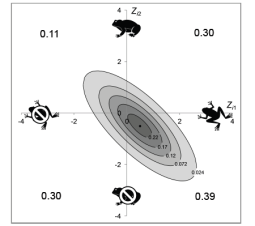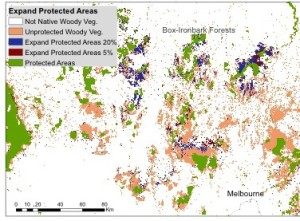Current research:
- Advances in Biodiversity modelling
- The biogeography of species interactions
- Conservation applications: extinction risk and spatial priorities
Advances in biodiversity modelling
Biodiversity models are a way to understand and predict the spatial distribution of taxa across the landscape. By far the most prominent of these models are Species Distribution Models (SDMs), which have served the dual purpose of providing scientific insight across fields of ecological research (e.g. community ecology, macro-ecology, biogeography) as well as being a go-to tool for predicting climate change impacts on species and other conservation applications.
The problem? Most SDMs overlook processes considered to be fundamental in ecology (e.g. species interactions, evolutionary history, dispersal constraints.. basically anything other than climate). This can lead to misleading or wrong predictions of biodiversity change and loss.
There is now a new generation of biodiversity models that are beginning to address these issues. We work to test and improve these models.
AI and Biodiversity Change (ABC)

We are very excited to be part of the new AI and Biodiversity Change Global Climate Center funded by the National Science Foundation (NSF) Global Centres Initiative. As part of this initiative, our lab alongside David Rolnick and colleagues at MILA are developing an early warning system for species change in Canada. More soon!
Joint Species Distribution Models (JSDMs)
 A key innovation in distribution modelling is to model multiple species simultaneously while accounting for their correlated occurrence (when they co-occur together and when they don’t, and how that relates to their position in the environment).
A key innovation in distribution modelling is to model multiple species simultaneously while accounting for their correlated occurrence (when they co-occur together and when they don’t, and how that relates to their position in the environment).
They allow us to better understand why species co-occur. Is it the environment? Is it something else (e.g. species interactions)? They also have potential for improving predictions of biodiversity loss. Read more about some statistical advantages here, here, and here.
See more explanation on JSDMs here. JSDM methods are rapidly evolving and have even been called the ‘Wild West of ecological statistics’.

We are currently focused on matching the hopes and dreams of JSDMs with what they can actually do with collaborators from QAECO and LECA.
What type of species interactions could be expect to detect with JSDMs? Mutualism, predation, competition? To answer this, we are testing JSDMs from multiple angles with real and simulated datasets of competition and food webs.
Refs:
Hartig, F, Abrego, N, Bush, A, Chase, JN, Guillera-Arroita, G, Leibold, MJ Ovaskainen, O, Pellissier, L, Pichler, M, Poggiato, G, Pollock, LJ, Si-Moussi, S, Thuiller, WJ, Viana, DJ, Warton, DI, Zurell, E, Douglas, WU. 2024 Novel community data in ecology-properties and prospects. Trends in Ecology and Evolution. https://doi.org/10.1016/j.tree.2023.09.017
Pollock, L.J., Tingley, R., Morris, W.K., Golding, N., O’Hara, R.B., Parris, K.M., Vesk, P.A., and McCarthy, M.A. 2014. Understanding co-occurrence by modelling species simultaneously with a Joint Species Distribution Model (JSDM). Methods in Ecology and Evolution 5:397.
Zurell, D, Pollock, LJ, Thuiller, W. 2018. Do joint species distribution models reliably detect interspecific interactions from co-occurrence data in homogenous environments? Ecography. doi:10.1111/ecog.03315.
.
Trait Species Distribution Models (Trait-SDMs)
One way to both test the link between the species and environment and (potentially) improve SDM predictions is to account for the effect of functional traits. If species are predicted to occur in a certain environment and the traits explain that link, then there is better evidence that that both trait and the environmental variable have a fundamental role.

We have an long-term project to understand trait-environment links for the Eucalypts in Australia with Pete Vesk, Will Morris, Karel Mokany and others. We are expanding our work in SW Victoria to all of southeastern Australia, which involves combining two massive, high-quality datasets, hard-core fieldwork collecting traits for all species, and some fancy models. More to come..
Refs:
Pollock, LJ, Kelly, LT, Thomas, FM, Paing Soe, Morris, WK, White, M, Vesk, PA. 2018. Combining functional traits, the environment, and multiple surveys to understand semi-arid tree distributions. Journal of Vegetation Science.
Pollock, L.J., Morris, W., Vesk, P. A. 2012. The role of functional traits in species distributions revealed by a hierarchical model. Ecography 35: 716-725
.
The geography of species interactions
In theory, species interactions are important to where species occur, but in practice, interactions can be elusive. It’s often assumed that species interactions are more important at a local scale (such as within a 10x10m plot), and less important at a regional scale. However, when predicting how species interactions impact a species across its distribution, this dichotomy is not always helpful (and not well-tested). A major obstacle is that empirical, observations of species interactions are limited to select, well-studied taxa, and are much less available than other data types (species distribution data, environmental data, trait data, etc).
Here, we are aiming for a geographically-continuous picture of species interactions, and this requires some creative data, creative solutions, and creative models! In particular, we are investigating the role of expert-based species interactions, and Species Interaction SDMs. We are also very interested in how to integrate species interactions into conservation planning. These goals have been part of our BiodivERsA project ‘FutureWebs’ with Wilfried Thuiller and our Canadian meta web project.
Refs:
Caron, D, Brose, U, Lurgi, M, Blanchet, G, Gravel, D, Pollock, LJ. 2024. Trophic interaction models predict interactions across space, not food webs. Global Ecology and Biogeography.
Gauzere, P, O’Conner, L, Botella, C, Poggiato, G, Munkemuller, T, Pollock, LJ, Brose, U, Maiorano, L, Harfoot, M, Thuiller, W. 2022. The diversity of biotic interactions complements functional and phylogenetic facets of biodiversity. Current Biology https://doi.org/10.1016/j.cub.2022.03.009
O’Connor, L, Pollock, LJ, ..Thuiller, W. 2020. Unveiling the food webs of tetrapods across Europe through the prism of the Eltonian niche. Journal of Biogeography 47:44.
Thuiller, W, Pollock, LJ, Gueguen, M, Münkemüller, T. 2015. From species distributions to meta-communities. Ecology Letters 18 (12), 1321-1328.
.
.
Establishing conservation priorities
Only a small fraction of the total biodiversity on the planet is considered in conservation planning and practice. While there are many good reasons for protecting highly threatened and visible species, at the same time, it’s important to consider a broader view of biodiversity beyond these important species to identify potential taxa, clades or functions that are missing from current conservation efforts. We now have an unprecedented opportunity for such an assessment given the ever-accumulating biodiversity data and findings from macro-ecological/biogeography research.

We have methods to link phylogenies to Species Distribution Models (SDMs) that integrate links between species (e.g. phylogenetic and functional diversity, and species interactions (coming soon..) into spatial conservation prioritisation.
At a species level, we are also developing a range of ways to rank species for conservation priority including those that are globally endangered and evolutionarily distinct EDGE and those that have documented human uses and ties to ecosystem services:
Refs:
Eckert, I, Brown, A, Caron, D, Riva, F, Pollock, LJ. 2023. 30×30 biodiversity gains rely on national coordination. Nature Communications. 14:7113.
Chauvier-Mendes, Y, Pollock, LJ, Verburg, PH, Karger, DN, Pellissier, L, Lavergne, S, Zimmermann, NE, Thuiller, W. 2024 Transnational conservation to anticipate future plant shifts in Europe Nature Ecology and Evolution. https://doi.org/10.1038/s41559-023-02287-3
Gumbs, R, Gray, CL, Hoffman, M, Molina-Venegas, R, Owen, NR, Pollock, LJ. 2023. Conserving avian evolutionary history can effectively safeguard future benefits for people. Science Advances. 9:eadh4686.
O’Connor, L.M., Pollock, L.J., Renaud, J., Verhagen, W., Verburg, P. H., Lavorel, S., Maiorano, L., and Thuiller, W. 2021. Balancing conservation priorities for nature and for people in Europe. Science 372:856. Abstract Reprint Full Text.
St-Laurent, O, Mokany, K, Pollock LJ. 2023. Safeguarding eucalypt diversity through conservation-focused tree planting. Journal of Applied Ecology 60: 519.
Pollock, LJ, Thuiller W, Jetz, W. 2017. Large conservation gains possible for global biodiversity facets. Nature. 546:141.
Pollock, LJ, Rosauer, DF, Thornhill, AH, Kujala, H, Crisp, MD, Miller, JT and McCarthy, MA. 2015. Phylogenetic diversity meets conservation policy: small areas are key to preserving eucalypt lineages. Philosophical Transactions of the Royal Society B: Biological Sciences 370(1662): 20140007.
